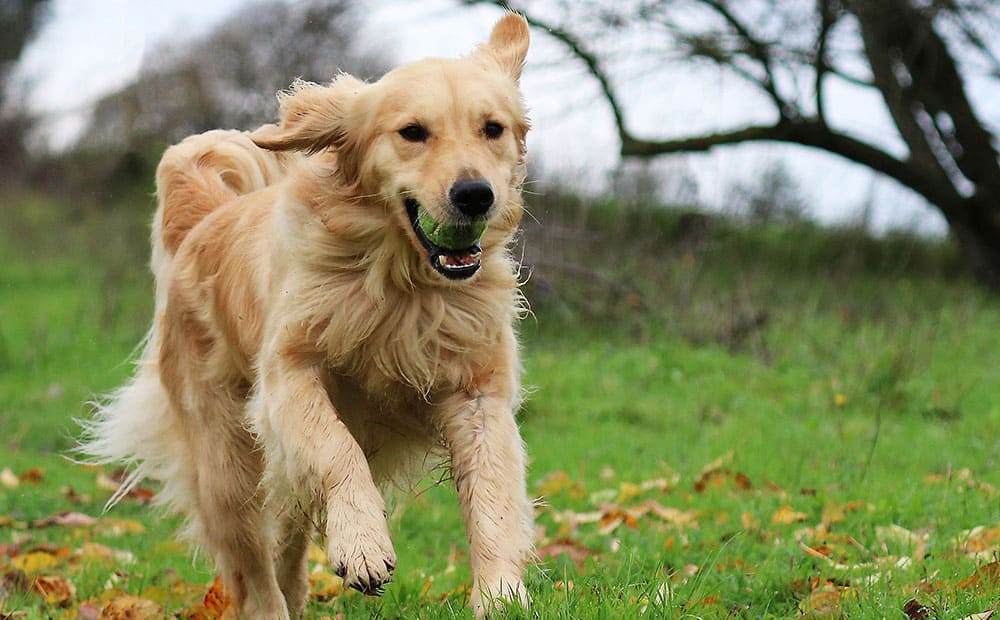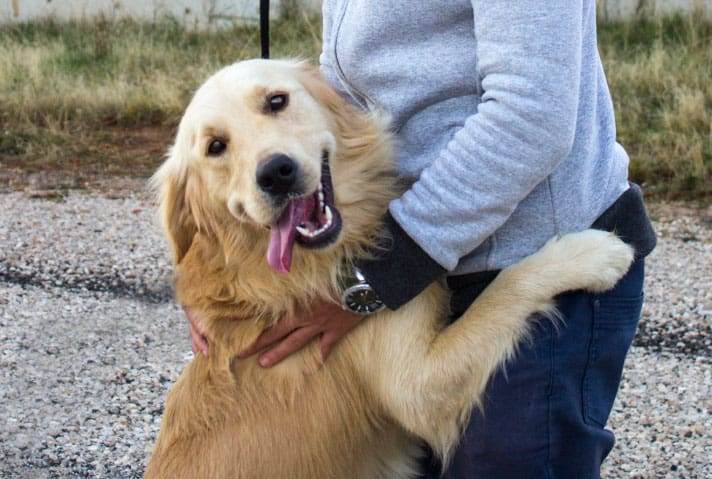Golden Retriever dog is so much full of energy. When you get a Golden puppy to your home, be prepared to get doses of energy bursts from the new canine friend.
So the natural question from new Golden Retriever owners is When will this Golden Retriever Calm down? With age, the energetic behavior of Retriever family dogs (both Golden and Labrador) starts to settle down. At the age of 2-3 years, they start to show an understanding of the world and obey commands. At that time, it is enjoyable to own the Golden Retriever.
Every retriever dog is different. Some may take 2-3 years and others may show some maturity by 5 years. What I can tell from my experience is that even though their body grows up but the mental growth of Golden Retriever dogs is slow and is not at par with physical growth.
Energy Levels in Golden Retrievers
Retrievers, more so the Golden Retriever is not a stationary animal. They need to receive physical and mental exercise in order to keep them contented. One of the reasons why Retrievers are hyperactive is because they do not receive enough exercise.
Retrievers are a breed that is full of energy and they need regular exercises and when they do not get it, their hyperactivity is more pronounced.
To dispense this energy, you should take your retriever out for jogs, walks, and runs. If there is no one in your home for 8-10 hours in a day, a Golden Retriever is not the pet for you as it needs exercise every day.
Golden Retrievers are hyperactive in nature as they are an energetic breed of dogs. Also, age is a factor when it comes to hyperactivity in Golden Retrievers. Puppies are more hyperactive than grown-up Retrievers; their hyperactivity involves stealing socks and other home objects. To curb this, take them out a number of times in a day and for one long expedition at least once a week.
Puppies tend to be more hyperactive than grown dogs thus you should expect it to tone down as it gets older. But, you should start training it to be calm when it is still a puppy to make it more manageable when it becomes an adult.

What You Can Do to Keep Your Retriever Stay Calm
Naturally, Golden Retrievers are an energetic breed of dogs; this is why they never seem to get tired. One reason why they get hyper is that they are not exercising as they should. Start by giving the Golden Retriever exercise at least one hour daily to keep them fully invigorated.
One type of exercise that is effective is playing fetch with the Golden Retriever. Fetch is an ideal exercise as it will not wear you out but will it will engage the dog sufficiently; if you choose to run with the dog, you will get tired before the Golden Retriever thus “Fetch” is a better game option.
The other type of exercise you can give your Golden Retriever is to let it join other dogs for a walk. When dogs are together, they play together where they will use energy while doing that. This will not wear you out as you will just have to watch as they play.
The other exercise option for your Golden Retriever is using a dog walker. The dog walker will provide exercise for your Golden Retriever without taking much of your time.
Golden Retrievers sometimes become hyper when they want to get your attention. If you ignore it, it will eventually calm down and if this continues, it will stop doing this as the action is not yielding any results. Pay attention to it when it is calm and it will start practicing being calm when it wants something from you.
Another thing that you can do to keep your Retriever calm is actually to train it to be calm. The training should start when the dog is still a puppy as initiating training when the Retriever is already grown-up will be very difficult.
You can actually train your Golden Retriever to be calm. You can do this by telling it to stop when it is hyper or to stay when it wants to go outside. Training will also teach the dog to wait for you to tell it whether or not to do things such as running out.
#1 Control Retriever’s Jumping Behavior
• The first step to control your Retriever’s jumping behavior is to pay attention to it only when it is on all four, that is when it is calmly standing. When your dog jumps at you, do not reward it by patting and getting personal with it; do not give it any attention either positive or negative.
Act as if the dog is not there; no pushing it away or even look at it. When you do this, the dog will be left wondering about just happened and even try to employ new tactics.
When in the process of wondering about your actions, it will go back on all fours; when in the position, you can turn and pat the dog, give treats, and praise it. However, do not excite the dog too much to the point of jumping up again.
If it jumps again, ignore it and walk away; they will eventually get that when they jump, they do not receive attention but they do when they are calm.
• Another way to control jumping is coming through the door when the dog is inside. Once you open the door, say hello to your dog. If it jumps on you, turn away and close the door. Stay away for about 30 seconds then get in again and greet your dog again, if it behaves in the same manner, repeat the procedure until he gets it.
• The third way is to come home with ready treats for your dog. Immediately you walk through the door, ask your dog to sit and reward him with the treats, gentle petting, and kind words. If it jumps up, withdraw the treat and walk away and repeat the process starting with coming through the door.

#2 Teach the Dog to WAIT for Signal to Start Eating Food
• Take the dog’s food bowl and put a treat in it, place the bowl at the level of the dog’s chest
• Ask the dog to sit or if he prefers to stand, he can stand. Put the food bowl about 6 inches towards the ground and ask the dog to “wait”. If the dog stays or stands stationary when you lower down the bowl, praise him gently.
If the dog starts to move when you start to lower down the bowl, place it up again and repeat the procedure.
• When your dog waits for you to lower the bowl, place it on the ground at once. Wait for a few seconds and give the cue to eat.
• After successfully waiting for the cue to eat even when the food is in front of the treat, use the same tactic with foods of higher value and proceed to mealtimes using the same techniques.
#3 Dog Toys Help a Lot
• Giving toys to your dog is another way of keeping them calm especially when you are leaving the house. For most people, their dogs behave like a little child and become anxious when they realize that their owner is leaving.
• Provide a stimulating dog toy to aid in converting the nervous energy to good use. A dog toy will keep your dog busy; an example is a puzzle toy that is ideal for a nervous dog as it will put the dog in a relaxed state.
• You can also hide toys from your dog and keep him guessing where he will search for the toys throughout the day. This will keep him busy preventing unnecessary hyperactivity; it is important to find the right toy for your Retriever.
You Need to Stop Encouraging Bad Behavior as a Puppy Too
Training calmness in a Retriever starts when the dog is still a puppy. Retrievers are hyperactive in nature, more so in the first three years of life. Naturally, all puppies are very playful despite the breed; Retrievers being an energetic lot is, therefore, more playful.
Do not reward bad behavior at any time as when you do it when the dog is a puppy, it will grow up with the behavior and it will be hard to change the habit once the puppy becomes an adult.
Always remember that Golden Retrievers are hyperactive in nature as they are an energetic breed of dogs. Also, age is a factor when it comes to hyperactivity in Golden Retrievers.
Puppies tend to be more hyperactive than grown-up dogs thus you should expect it to tone down as it gets older. But, you should start training it to be calm when it is still a puppy to make it more manageable when it becomes an adult.
You might also want to consider Crate training for your Golden Retriever though some people consider it a form of punishment for the dog.
However, training your Golden Retriever to properly use its crate will make it see the crate as a personal safe area. You will, therefore, get it to stay in the crate when it starts misbehaving.
If all the above measures don’t work, or you don’t have the time to train or exercise your Golden Retriever, you can buy a chew that is designed to calm down your Golden Retriever.
However, do not give the dog the chew when misbehaving as it will think that it’s being rewarded for misbehavior; give it when it is calm instead.
When all methods to calm down your Golden Retriever fail, you can enlist the help of a professional behaviorist. The animal behaviorist will advise you on custom-tailored techniques to help your Golden Retriever calm down.
References
- https://dspace.library.uu.nl/handle/1874/8698
- https://citeseerx.ist.psu.edu/viewdoc/download?doi=10.1.1.622.2106&rep=rep1&type=pdf
Table of Contents
